The kiondo basket bag is a powerful symbol of Kenya’s cultural heritage. You’ll notice its intricate designs and vibrant colors that represent various symbols, like protection, fertility, or unity. These baskets reflect local traditions, social status, and community pride, often handcrafted using age-old techniques passed down through generations. As it evolves with modern styles, it still preserves its deep cultural roots. Keep exploring to discover the full story behind this iconic Kenyan craft.
Key Takeaways
- Kiondo baskets embody Kenya’s cultural heritage, with designs and symbols conveying community stories, spiritual beliefs, and social status.
- They serve as symbols of cultural identity, pride, and social connection within Kenyan communities.
- The intricate craftsmanship and motifs reflect traditional skills passed down through generations.
- Colors and patterns on kiondos carry specific cultural meanings, representing values like unity, fertility, and bravery.
- Wearing or carrying a kiondo celebrates Kenyan heritage and promotes the preservation of traditional artisan techniques.
Origins and Traditional Craftsmanship of the Kiondo
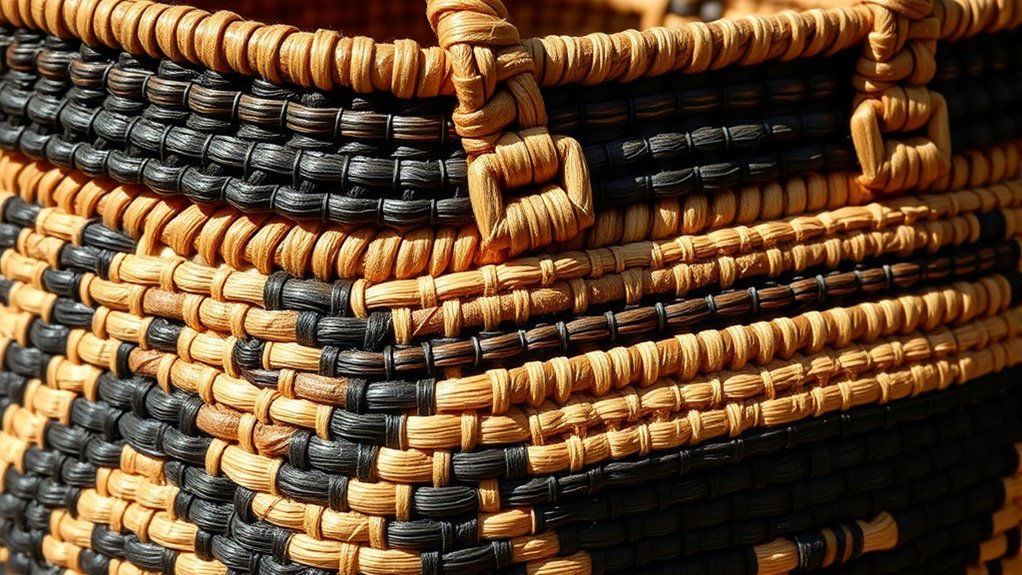
The origins of the kiondo basket are deeply rooted in Kenya’s rich cultural heritage, with craftsmanship passing down through generations of artisans. You’ll find that kiondo weaving is a meticulous process, involving tightly interlaced strips of raw materials like sisal or straw. Artisans often incorporate traditional dyeing techniques to add vibrant colors, using natural dyes derived from plants and minerals. This traditional dyeing not only enhances the basket’s appearance but also preserves cultural practices. Skilled craftspersons spend hours, sometimes days, perfecting each piece. The weaving patterns and dyeing methods vary across regions, reflecting local customs and skills. This deep-rooted craftsmanship ensures that each kiondo is a unique artifact, embodying Kenya’s artistic heritage and cultural identity. Additionally, the use of natural dyes contributes to color longevity, ensuring the vibrancy of each basket over time. The vibrant colors and intricate patterns also serve to preserve cultural traditions, passing stories and symbolism from generation to generation. Moreover, recent initiatives focus on sustainable craftsmanship techniques to promote environmental conservation and cultural preservation, underscoring the cultural importance of these traditional practices.
Symbols and Meanings Embedded in the Design

You’ll notice that the designs on kiondo baskets carry deep meaning through traditional symbols and motifs. The colors used also convey specific messages and cultural values. Together, these elements reflect your community’s identity and pride, making each basket more than just a functional item. Incorporating cultural symbolism into their design, artisans preserve and celebrate their heritage with each weave. This practice helps maintain a cultural identity that is passed down through generations, ensuring the continuity of their traditions.
Traditional Symbols and Motifs
Traditional symbols and motifs woven into the Kiondo basket carry deep cultural meanings that reflect community values, beliefs, and histories. These patterns often depict everyday life, spiritual beliefs, and social status, making each basket a storytelling piece. While modern fashion has embraced Kiondos for their aesthetic appeal, many designs retain symbolic significance. When you see a Kiondo as a tourist souvenir, you might notice motifs representing protection, fertility, or unity, conveying messages beyond their visual appeal. These symbols connect generations, preserving cultural identity amid changing trends. By understanding these motifs, you gain insight into the community’s worldview, making the basket more than just a stylish accessory; it’s a vessel of tradition and meaning. Additionally, the craftsmanship involved in creating Kiondos reflects skills passed through generations, emphasizing the importance of preserving traditional techniques in craft. Recognizing the cultural symbolism embedded in the designs enhances appreciation for the artistry and cultural heritage of the artisans.
Color Significance and Meaning
Colors woven into Kiondo baskets are more than just eye-catching; they carry specific meanings rooted in cultural beliefs and social messages. Understanding color symbolism helps you appreciate how these vibrant hues communicate important cultural expressions. For example, red often signifies bravery or love, while blue symbolizes peace and harmony. Yellow can represent wealth or fertility, and black stands for unity or resilience. These colors are thoughtfully chosen to reflect the weaver’s message or status. Here’s a quick guide:
| Color | Symbolic Meaning | Cultural Expression |
|---|---|---|
| Red | Courage, love | Celebrations, warrior status |
| Blue | Peace, harmony | Community bonds |
| Yellow | Wealth, fertility | Prosperity |
| Black | Unity, resilience | Social cohesion |
Understanding these color meanings enhances your appreciation of the symbolic significance embedded in each basket, making it a meaningful cultural artifact.
Cultural Identity and Pride
The intricate patterns and symbols woven into Kiondo baskets serve as powerful expressions of cultural identity and pride. These designs reflect specific communities, stories, and traditions, making each basket a unique symbol of heritage. As fashion trends evolve, many people worldwide embrace the Kiondo as a stylish statement, helping spread Kenyan culture. Tourism influence plays a significant role in showcasing these symbols, encouraging artisans to preserve traditional patterns while adapting to modern tastes. When you carry a Kiondo, you’re not just using a bag; you’re celebrating a rich cultural identity. The designs resonate deeply with local pride and history, allowing you to connect with Kenya’s heritage while embracing contemporary fashion. It’s a meaningful way to honor tradition through everyday style. Additionally, the process of weaving Kiondo baskets often involves traditional craftsmanship, which is a vital aspect of maintaining cultural practices and skills passed down through generations. This craft also supports cultural preservation, ensuring that these meaningful symbols continue to be passed on and appreciated by future generations. The vibrant colors and intricate motifs also reflect the community’s artistic expression, making each piece a wearable piece of art that embodies local creativity and symbolism. Moreover, these baskets serve as a form of cultural identity, reinforcing community bonds and shared histories through their unique designs.
The Kiondo’s Role in Kenyan Social and Cultural Identity
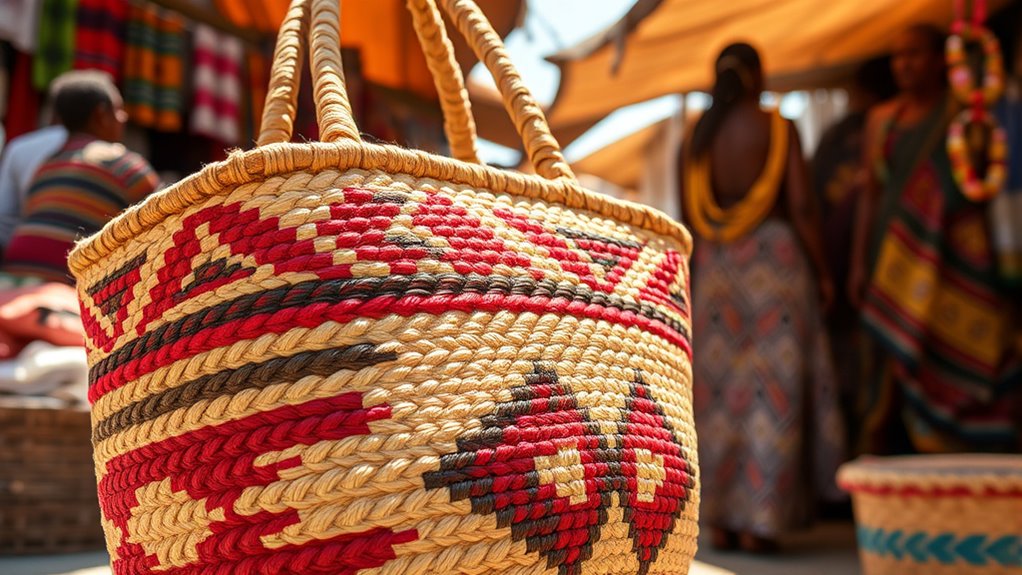
You can see how the kiondo reflects Kenya’s rich cultural heritage and helps keep traditions alive. It also serves as a symbol of status, showing your connection to community and history. By carrying a kiondo, you actively participate in preserving cultural identity and honoring ancestral practices. Additionally, the kiondo embodies aspects of personal development by fostering a sense of pride and belonging within the community.
Cultural Heritage Preservation
Because the kiondo basket has long been woven into Kenyan communities’ daily lives, it plays an essential role in preserving cultural heritage and shaping social identity. This tradition sustains local craftsmanship and promotes Kiondo sustainability by encouraging continuous artisan skills. You can see this in:
- The passing down of weaving techniques across generations, maintaining cultural continuity.
- The empowerment of artisans, providing them with a livelihood and preserving their craft.
- The promotion of cultural pride through the global appreciation of these baskets, reinforcing Kenya’s identity.
- The increasing interest in alternative investments, such as traditional crafts, which helps ensure the economic sustainability of artisan communities. Additionally, supporting local artisans helps prevent the spoiling of cultural knowledge, ensuring these skills are preserved for future generations. Recognizing the significance of textile art techniques in traditional crafts further enhances the cultural value of the Kiondo. Moreover, incorporating sustainable practices in the production process ensures the preservation of both environmental integrity and cultural heritage. Emphasizing community involvement also fosters a sense of shared responsibility for safeguarding these cultural assets.
Symbol of Status
Kiondo baskets do more than serve practical purposes; they also act as symbols of social status and cultural identity in Kenya. In social settings, the quality, design, and craftsmanship of your kiondo can signal your standing within the community. As fashion trends evolve, contemporary designs of the kiondo become more popular among urban elites, blending traditional techniques with modern aesthetics. Choosing a well-crafted, stylish kiondo shows that you value cultural heritage while staying current with fashion trends. The kiondo’s role as a status symbol highlights your appreciation for Kenyan craftsmanship and your place within the social fabric. Wearing a distinctive kiondo reflects pride and cultural connection. Additionally, the increasing use of AI security in safeguarding cultural heritage and traditional crafts ensures that these symbols of identity are protected in the digital age. Recognizing the importance of cultural preservation helps sustain these traditional crafts for future generations. The integration of digital technology into artisan practices offers new opportunities for artisans to reach wider audiences and promote their work globally. As interest in heritage conservation grows, more artisans are able to showcase their work to a broader audience, strengthening cultural pride.
Evolution and Modern Adaptations of the Kiondo
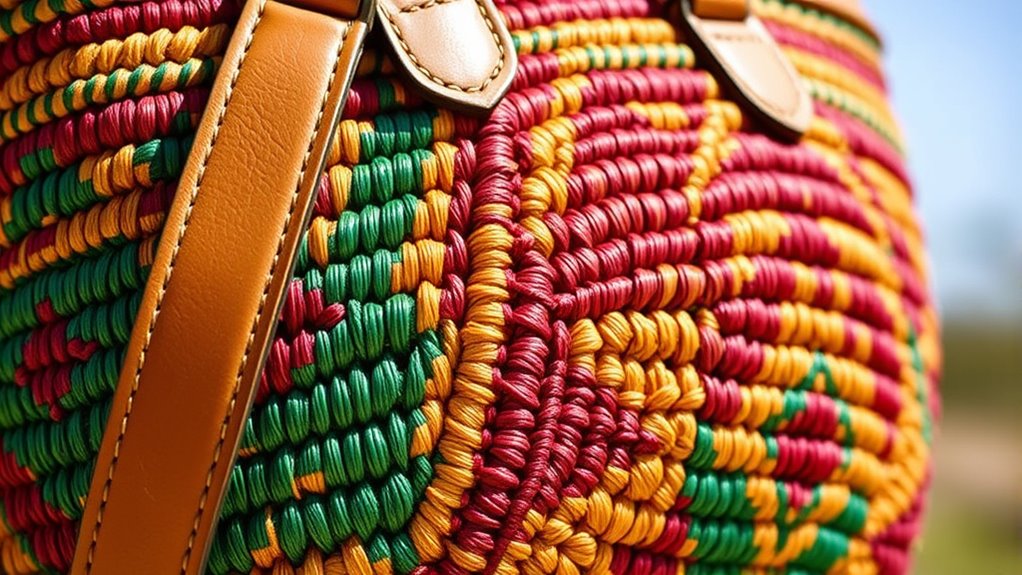
Over time, the kiondo has evolved from a purely utilitarian item into a versatile symbol of Kenyan heritage that adapts to contemporary fashion. Today, designers incorporate urban influences, blending traditional craftsmanship with modern styles. This results in kiondos that appeal to a broader audience, from fashion-forward individuals to everyday users.
Some key modern adaptations include:
- Incorporation of vibrant colors and patterns for trendy appeal
- Use of alternative materials like leather or synthetic fibers for durability
- Integration into streetwear and accessory collections influenced by contemporary fashion
These changes keep the kiondo relevant, allowing it to thrive in urban environments while honoring its cultural roots. You now see it as both a cultural artifact and a stylish accessory.
The Kiondo in Kenyan Economy and Global Markets
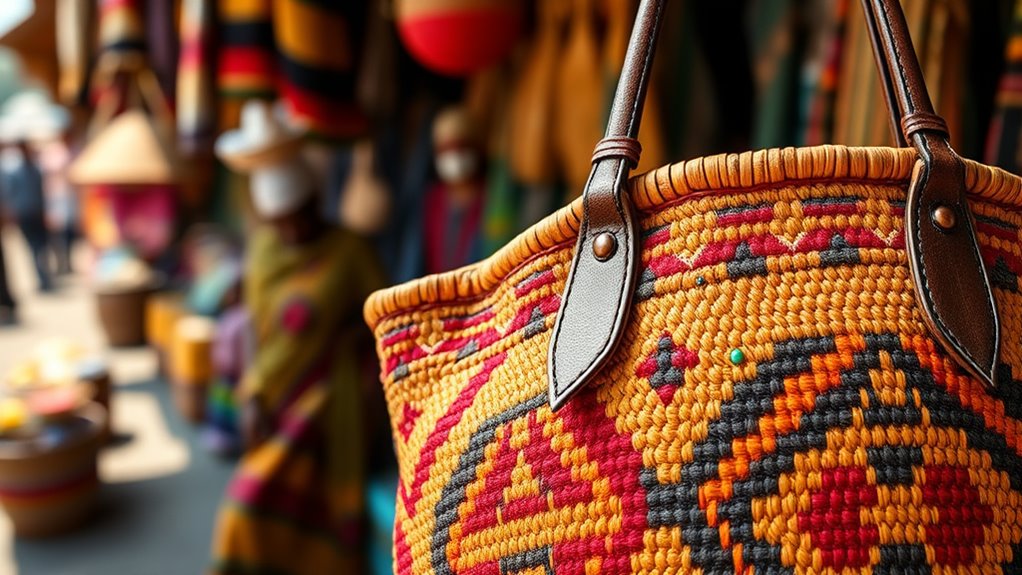
The growing popularity of the kiondo beyond Kenya’s borders has transformed it into a significant player in both the national economy and international markets. You’ll notice that global market trends favor handmade, ethically produced crafts, which boosts export opportunities for Kenyan artisans. As demand rises, the kiondo becomes more than a cultural symbol; it’s a valuable commodity that generates income and supports local communities. International buyers increasingly seek authentic, sustainable products, aligning perfectly with the kiondo’s handcrafted appeal. This shift opens doors for artisans to expand their reach, tap into new markets, and boost Kenya’s export revenue. By embracing global trends, you help preserve this traditional craft while strengthening Kenya’s position in the global marketplace.
Preserving Heritage: Challenges and Opportunities
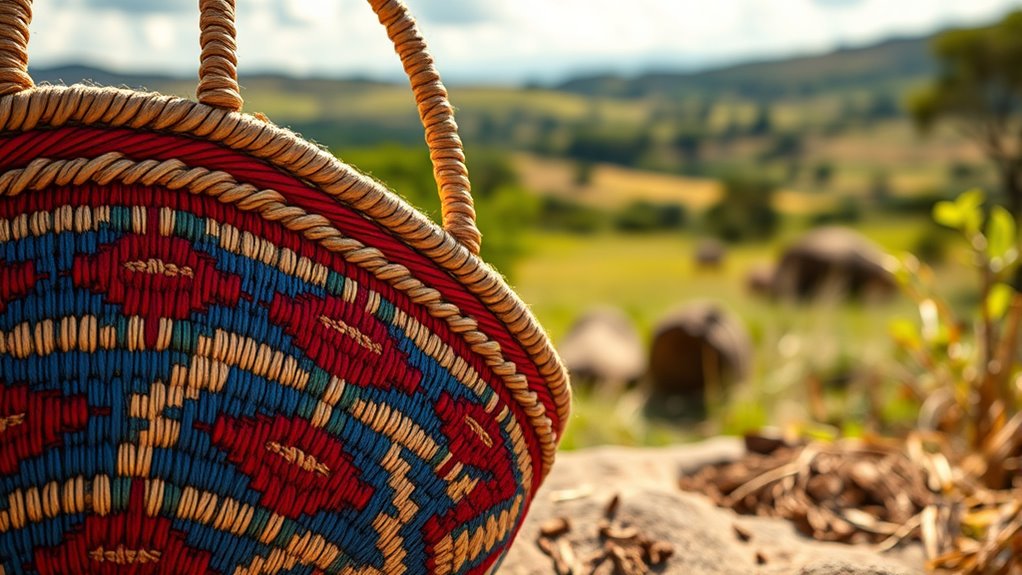
Preserving the cultural heritage of the kiondo basket faces significant challenges as modernization and globalization threaten traditional craftsmanship. You must navigate these obstacles to keep the craft alive. Opportunities arise when you adapt kiondo designs to fit contemporary fashion trends and urban lifestyles. This urban adaptation attracts younger generations and international markets. Consider these strategies:
Adapting kiondo designs to modern trends helps preserve and celebrate cultural heritage globally.
- Incorporate modern colors and patterns to appeal to contemporary fashion enthusiasts.
- Collaborate with designers to blend traditional techniques with current trends.
- Promote the cultural significance of the kiondo through digital platforms to reach global audiences.
Frequently Asked Questions
How Do Kiondo Baskets Influence Kenyan Fashion Trends Today?
You notice how kiondo baskets are shaping Kenyan fashion trends today. They’ve become bold fashion statements and popular accessory trends, blending tradition with modern style. You might see them paired with contemporary outfits, adding unique flair. Their vibrant patterns and craftsmanship make them stand out. As an eye-catching accessory, the kiondo influences how fashion evolves, inspiring both local designers and fashion lovers to embrace cultural heritage while staying trendy.
Are There Specific Regions in Kenya Renowned for Kiondo Craftsmanship?
Think of Kenya’s regions as vibrant threads woven into a rich tapestry, each famous for its kiondo craftsmanship. You’ll find the Maasai in southern Kenya, renowned for their intricate designs, and the Kikuyu in central regions, celebrated for their durable baskets. These areas showcase regional craftsmanship that preserves cultural heritage, making each kiondo a unique symbol of tradition and artistry in Kenyan culture.
What Are the Environmental Impacts of Kiondo Basket Production?
You might wonder about the environmental impacts of kiondo basket production. By practicing sustainable harvesting of natural materials like sisal and reeds, artisans help promote environmental conservation. This approach reduces deforestation and pollution often caused by synthetic alternatives. When you support kiondo craftmanship that emphasizes eco-friendly methods, you’re contributing to the preservation of Kenya’s natural resources while enjoying a beautiful, culturally significant product.
How Do Kiondo Baskets Compare to Other Traditional African Basketry?
You might think all traditional African baskets are similar, but kiondo baskets stand out. Their intricate weaving techniques showcase expert craftsmanship, and the material diversity—like sisal, sweetgrass, and leather—adds unique character. While other baskets emphasize functionality, kiondos blend utility with cultural artistry, evoking pride and identity. Comparing them highlights Kenya’s rich weaving traditions, inspiring appreciation for how these baskets preserve heritage through skill and diverse materials.
Can Kiondo Baskets Be Used for Purposes Other Than Carrying or Storage?
You can definitely use kiondo baskets beyond carrying or storage. Many people appreciate their decorative uses, displaying them as wall art or table centerpieces. Additionally, in ceremonial purposes, kiondos often appear in traditional events or rituals, symbolizing cultural heritage. Their vibrant colors and intricate designs make them versatile, serving both functional and aesthetic roles in various settings, enriching the cultural experience.
Conclusion
So, while the kiondo now graces runways and markets worldwide, it’s ironic that its deep cultural roots often go unnoticed. You might carry this beautiful basket, but don’t forget its stories and traditions. As modern trends push for novelty, the true essence of the kiondo risks being lost in the shuffle. Perhaps the greatest irony is that something so historically rich is now a symbol of fleeting fashion rather than cultural pride.








